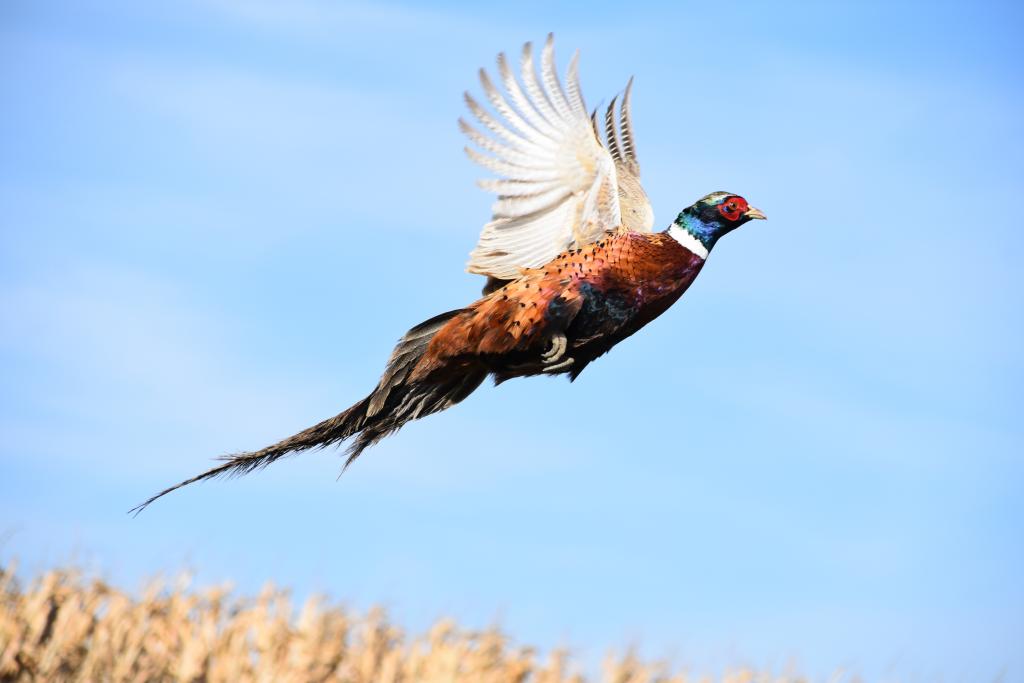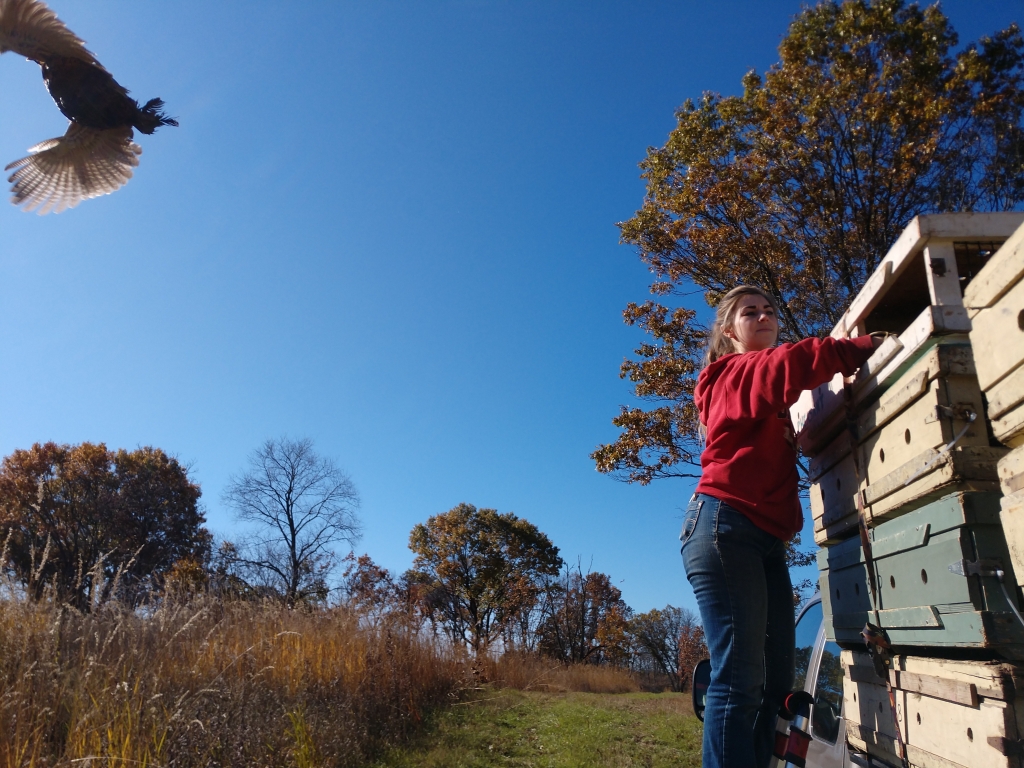Pheasant hunting and management
Pheasant hunting has long been a Wisconsin tradition. The ring-necked pheasant was introduced as a game bird to Wisconsin as early as the late 1800s. Ideal habitat conditions allowed the population to flourish and expand rapidly. In the 1940s, the pheasant population declined due to limited habitat availability, modern agricultural practices and urbanization. Today's pheasant population is most common in the west-central and southeastern regions of the state.
HPAI Information
In the spring of 2022, a strain of highly pathogenic avian influenza (HPAI) was detected in numerous domestic and wild birds throughout Wisconsin. It is expected that the virus will continue to circulate in wild bird populations this year. In general, upland birds such as pheasants have behaviors and prefer habitats that make them less likely to encounter avian influenza viruses in the wild.
Hunters should never harvest wild birds that appear sick. If you observe a sick pheasant, contact the DNR's Wildlife Switchboard by emailing DNRWildlifeSwitchboard@wisconsin.gov or leaving a voicemail for a return phone call at 608-267-0866.
This strain of HPAI does not pose a food safety risk. However, hunters should always ensure the proper handling of game meat. Harvested birds should be cooked to an internal temperature of 165°F.
The USDA website offers additional recommendations for hunters. For more information on avian influenza and other diseases affecting wildlife health, visit the DNR's wildlife diseases page.
Season dates
Regulations
Hours
Hunting hours vary depending on the time of year and location (northern or southern half of the state). Hunters can use the following documents to check hunting hours in the part of the state they hunt. For more information, see pages 29-31 of the Hunting regulations.
Pheasant Hunting Noon Closure Areas
Shooting hours deviate from standard times within the boundaries of the properties below. Pheasant hours for these properties close at noon on weekdays from October to November 3.
- Allenton Wildlife Area (W.A.) (Washington County)
- Brooklyn W.A. (Dane, Green)
- C.D. "Buzz" Besadny Fish and W.A. (Kewaunee)
- Dunnville W.A. (Dunn)
- Eldorado Marsh W.A. (Fond Du Lac)
- Goose Lake W.A. (Dane)
- Grand River W.A. (Green Lake, Marquette)
- Holland W.A. (Brown)
- Horicon W.A. (Dodge)
- Jackson Marsh W.A. (Washington)
- Killsnake W.A. (Calumet and Manitowoc)
- Mazomanie Unit, Lower Wisconsin State Riverway (Dane)
- Mud Lake W.A. (Dodge)
- Mud Lake W.A. (Columbia)
- New Munster W.A. (Kenosha)
- Nichols Creek W.A. (Sheboygan)
- Pine Island W.A. (Columbia, Sauk)
- Theresa W.A. (Dodge and Washington)
- Tichigan W.A. (Racine)
- Vernon W.A. (Waukesha)
- White River W.A. (Green Lake, Marquette)
Note: After Oct. 19, daily shooting hours are closed at 2 p.m. for all species at Richard Bong State Recreation Area, except that regular shooting hours apply while hunting waterfowl south of Hwy. 142 or while archery deer hunting.
Where to hunt
Find properties stocked with pheasants
- Fields & Forest Lands Interactive Gamebird Hunting Tool (FFLIGHT)
- Use this interactive mapping tool to locate properties stocked with pheasants, managed dove fields and suitable ruffed grouse or woodcock habitats. FFLIGHT also allows users to generate aerial, topographic and landcover maps while hunting.
- Pheasant Stocking Information
- Visit this webpage for property specific pheasant stocking information using a search tool.
Find properties open to public hunting.
- Voluntary Public Access program
- Through this program, hundreds of landowners have opened their land to the public for hunting, fishing, trapping and wildlife viewing. Over 30,000 acres of private land are accessible to the public and can be found using the VPA interactive map.
- Public land access
- From hunting and fishing to camping and hiking, use this resource to find everything you need to enjoy the outdoors.
Pheasant management
Pheasant stamp
All hunters who want to pursue pheasants must purchase a pheasant stamp. The funds generated from your pheasant stamp purchase go directly to habitat management for the ringed-necked pheasant in Wisconsin. Since 1992, over $10.6 million in pheasant stamp dollars and $7.9 million in partner dollars have been used to preserve, restore and manage thousands of acres of nesting and winter habitat throughout the state.
Population surveys
Each year, surveys are conducted to assess Wisconsin's wild pheasant population. Pheasant survey reports include:
- Spring Pheasant Survey
- Rural Mail Carrier Pheasant Survey Reports
- Preliminary Ten-Week Brood Observations
- Game Brood Survey
State Game Farm
The State Game Farm and the pheasant stocking program provide quality pheasant hunting opportunities on public and private lands, promote safe and ethical behavior in the field and cooperate with conservation groups dedicated to promoting pheasant hunting in the state. Learn more about the State Game Farm.
Pheasant Advisory Committee
The Pheasant Advisory Committee, a diverse group representing government agencies, non-governmental organizations, tribal interests and conservation groups, meets to discuss issues relating to pheasant management and the pheasant stamp program.
The Pheasant Advisory Committee reviews and makes recommendations on managing ring-necked pheasants in Wisconsin. The Committee advises the Wildlife Policy Team on various topics such as hunting regulations, surveys, research priorities, and put-and-take stocking efforts.
Committee meeting information
- Sept. 19, 2024 pheasant advisory committee meeting minutes
- July 25, 2023 pheasant advisory committee meeting minutes
- March 16, 2023 pheasant advisory committee meeting minutes
- Nov. 30, 2022 pheasant advisory committee meeting minutes
- Dec. 14, 2021 pheasant advisory committee meeting minutes
- Feb. 22, 2021 pheasant advisory committee meeting minutes
- Dec. 3, 2020 pheasant advisory committee meeting minutes
- May 28, 2019 pheasant advisory committee meeting minutes


